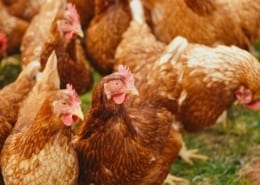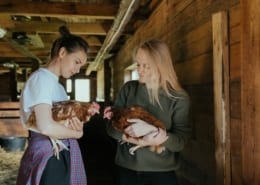Animal husbandry is a branch of agriculture concerned mainly with animals raised for meat, milk, eggs, fibre or other products. A combination of animal anatomy and physiology, this course is ideal for anyone working with or keen to increase their knowledge of animals, including cattle, goats, pigs, sheep and poultry.
The Certificate of Animal Husbandry is an online professional development program that mainly focuses on mammal species and provides a sound introduction to these animals’ health and biological systems.
In this animal husbandry course, you will explore animals’ cells, tissues, skeletons and muscles, and their respiratory, circulatory, urinary, nervous, digestive, endocrine and reproductive systems.
You will also learn about common diseases that affect farm animals, their signs and symptoms, treatment, and causes, including wounds, inflammation and cell changes.
On completion of this course, you will have a solid introduction to animal health, which will raise your awareness of the animal husbandry industry and create opportunities for employment or managing your own business.
Course Structure
Animal Husbandry I
Unit 1 – Introduction to Cells and Tissues
- Livestock classes
- Livestock products
- Interrelationship between crops and livestock
- Cells and tissues
- Special properties of cells
- Osmosis
- Nutrient waste
Unit 2 – The Digestive System
- Digestive system
- Mouth, tongue, teeth,
- Oesophagus
- Simple stomach
- Small intestine
- Large intestine
- Ruminant stomach
- Accessory organs of the digestive system
- Digestion
- Absorption and utilisation in the simple stomach
- Enzymes
- Breakdown by microorganisms
- Digestion, absorption and utilisation in the ruminant stomach
- Mechanical action
- Action of micro-organisms
- Utilisation of the end products of digestion
Unit 3 – The Circulatory System
- Circulatory system
- Composition of blood
- Functions of blood
- Clotting mechanism
- Immunity
- Blood vessels
- Arteries
- Veins
- Capillaries
- Physiology of the circulatory system
- Rates of heart beats
- Spleen
- Lymphatic system
- Circulatory networks
Unit 4 – The Urinary System
- Anatomy of the urinary system
- Kidneys
- Ureter
- Bladder
- Physiology of urinary system
- Excretion in different animals
Unit 5 – The Nervous System
- Central and peripheral nervous system
- Main parts of the nervous system
- Neurons
- Sensory neurons
- Motor neurons
- Central nervous system
- The brain
- Spinal cord
- Peripheral nervous system
- Cranial nerves
- Spinal nerves
- Autonomic nervous system
- Reflex actions
- Endocrine system
- Structure and function of the ear
- Hearing
- Structure and function of the eye
- The iris
- Structure and function of the nose
Unit 6 – Respiration
- Anatomy of respiration
- Trachea
- Bronchial tree
- Lungs
- Physiology of respiration
- Gaseous exchange
- Rate and depth of breathing
Unit 7 – The Reproductive System
- Anatomy of the male reproductive system
- Testes
- Accessory organs
- Penis
- Physiology of male reproductive system
- Hormone production
- Sperm production
- Erection
- Ejaculation
- Fertility problems in males
- Venereal diseases
- Other diseases
- Injury
- Physical immaturity
- Emotional immaturity
- Nutrition
- Poor handling
- Anatomy of female reproductive system
- Ovaries
- Fallopian tubes
- Uterus
- Cervix
- Physiology of the female reproductive system
- Ovulation, oestrus cycle
- Fertility problems, difficulties conceiving
- Venereal and other diseases
- Physical abnormalities
- Nutrition
- Inability to carry a foetus to full-term
- Pregnancy and parturition
- Fertilisation
- Pregnancy
- Parturition
- Birth process
- Difficult births
- Structure of the mammary glands
- Secretion of milk
- Milk ejection
- Reproduction data for cows, sows and ewes
Unit 8 – Muscles and Meat
- Muscles and meat
- Smooth muscle
- Striated voluntary muscle
- Cardiac muscle
- Structure of meat
- Dressing out percentage
- Composition of the beef animal
- Meat quality and tenderness
- Juiciness
- Flavour
- Cuts and joints of meat
Unit 9 – The Skeleton
- Bones
- How bones are formed
- Anatomy of bones
- Fractures and fracture healing
- Five types of bone
- Joints of bone
- The skeleton
- Dentition
- The dental formula
- Cattle
- Dental formula of an ox and cow
- Eruption of permanent teeth
- Pigs
Unit 10 – Animal Growth, Development, and the Endocrine System
- Growth and development
- Growth curve
- Prenatal growth
- Post-natal growth
- Fat
- Factors which affect the size of newborns
- Factors affecting post-natal growth
- Early maturing
- Compensatory growth
- Endocrine system
- Pituitary gland
- Thyroid
- Parathyroid
- Thymus
- Adrenal bodies
- Pancreas
- Testes
- Ovaries
- Pineal body
- Mucous membrane of the stomach
Unit 11 – Comparing Different Animals
- Poultry
- Digestion
- Gullet
- Crop
- Proventriculus
- Gizzard
- Intestine
- Caecum
- Rectum
- Incubating eggs
- Natural incubation
- Symptoms of a broody hen
- Fish
Study Hours
Estimated duration 50 hours
Course Delivery and Start
Start anytime, self-paced and 100% online
Assessment
Assessment will be comprised of written exercises, including short-answer questions, reflective tasks, short reports and/or projects. There are no examinations or due dates for assessment. As a result, you can complete training in your own time and at your own pace with the assistance of unlimited tutor support.
Approval and Recognition
Australian Online Courses Pty Ltd is an approved and recognised member of IARC. The IARC is an International association that recognises quality and excellence in tertiary education providers.
Testimonials
About Us
Graduation
A Certificate of Attainment and Statement of Results will be issued upon successful completion of this course.
How to Enrol
Enrolment Form – Employment Services and Rehabilitation Providers
Enrol via Live Chat (Business Hours)
Enrol via Telephone 1300 76 2221 (Business Hours)
Payment Options
Visa, Mastercard, BPAY and EFT/Direct Deposit. Please allow 1-2 Business days for processing for EFT and BPAY.
Course FAQs
Why Choose Australian Online Courses?
- Professional development that is widely recognised and respected;
- Improve your employment opportunities;
- Study online, anywhere via our elearning system;
- High-quality professional development programs written by industry experts;
- All course materials provided online – no textbooks to buy;
- Unlimited tutor support via email;
- We offer twelve (12) months’ access, with extensions available upon application (fees apply);
- Course may be tax deductible; see your tax advisor.
Are there any entry requirements or pre-requisites?
There are no course or subject pre-requisites for entry into our programs. However, our professional development programs are generally intended for people over the age of 18. In some circumstances, enrolments from younger people may be considered. Please complete the AOC Parent Guardian Consent Form prior to enrolling and submit here.
Are there any computer requirements?
To study online with Australian Online Courses you will need a computer (desktop PC/laptop) running a current/updated operating system with reliable high-speed internet access. You will need to use the Google Chrome browser to access your course.
When can I start this course?
You can start within 60 minutes during business hours when you enrol and pay in full with a credit card!
Credit card: Within 60 mins during business hours.
BPAY: Within 1-2 working days.
Internet Banking: Within 1-2 working days.
Cheque/Money Order: Upon receipt of mailed cheque.
How is this course delivered?
This course is delivered online via our easy-to-navigate Learning Management System (LMS), where you will discover interactive online learning/written content, resources and assessment.
Do I need to attend classes or undertake any work placements?
No. All courses are delivered online via our LMS and there are no work placement requirements in this course.
What support can I expect from Australian Online Courses?
Unlimited tutor support is available throughout your studies via email only during business hours Monday to Friday. Our Administrative team are available Monday to Friday via email, live chat and telephone.
I am an international student. Can I enrol into this course?
Yes! We accept enrolments from individuals both within Australia and internationally; location is no barrier to entry into our programs.
Career Pathways
Future growth
Strong
Unemployment
Low
- Those working or wanting to work with animals
- Volunteer animal workers








